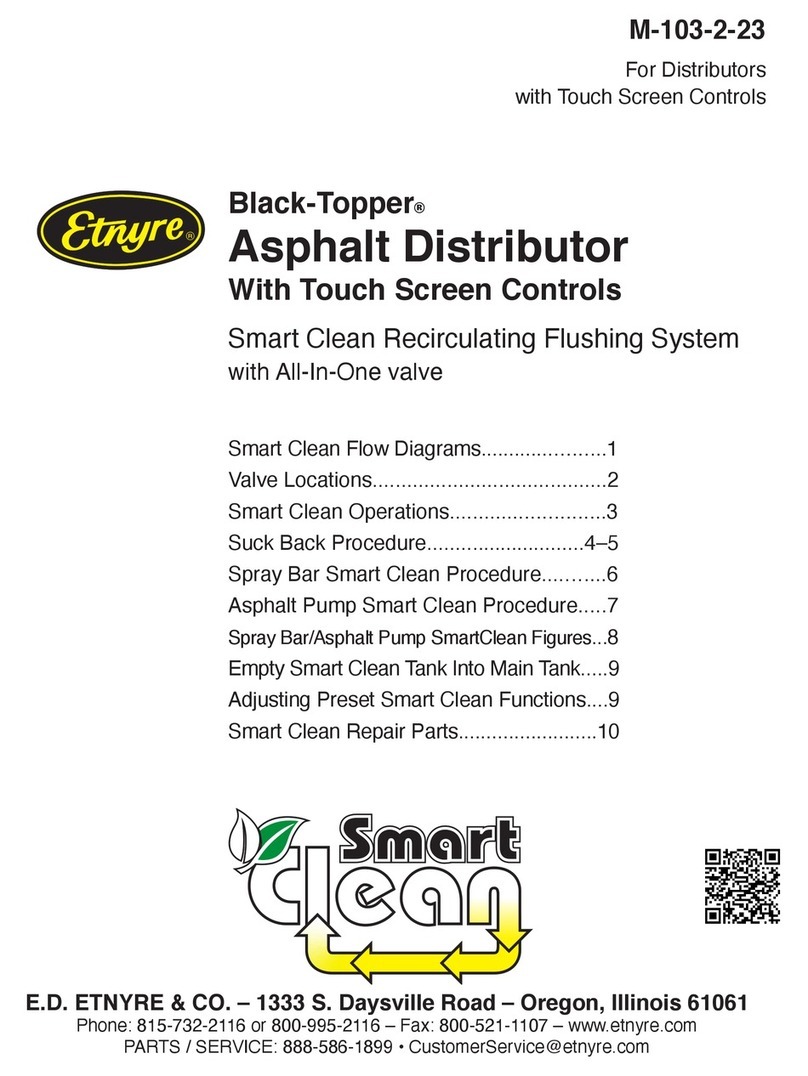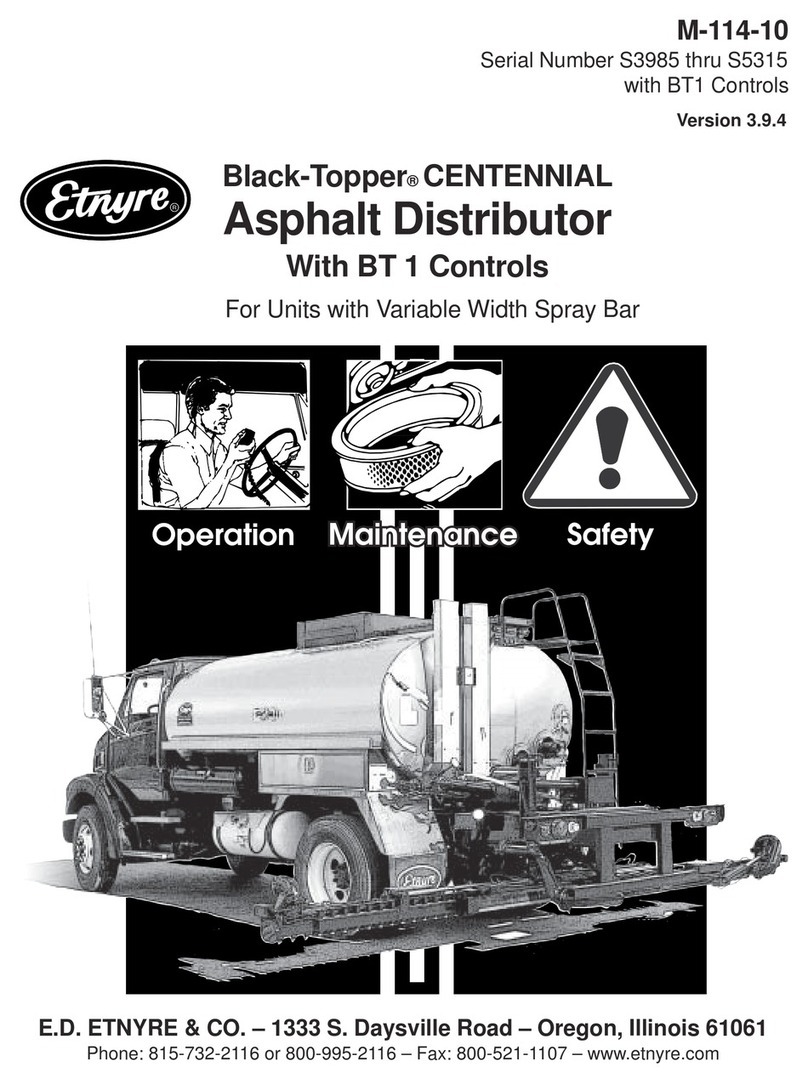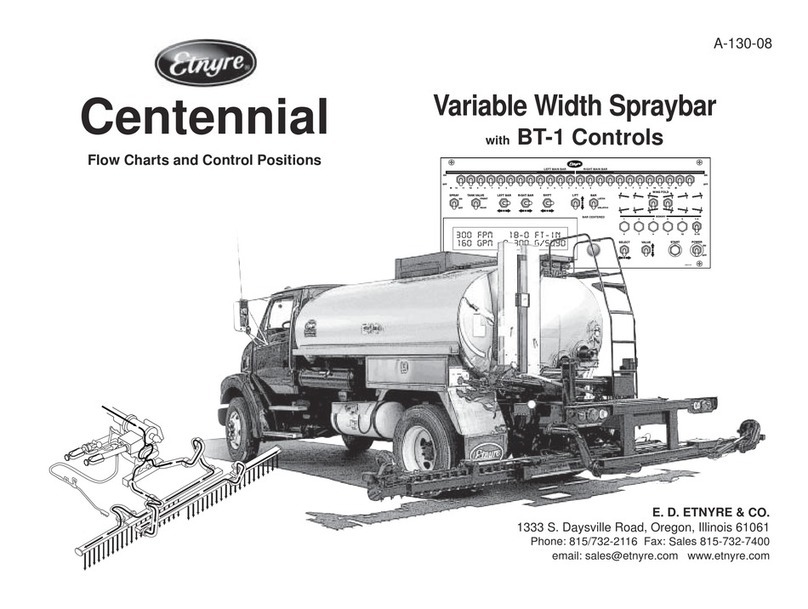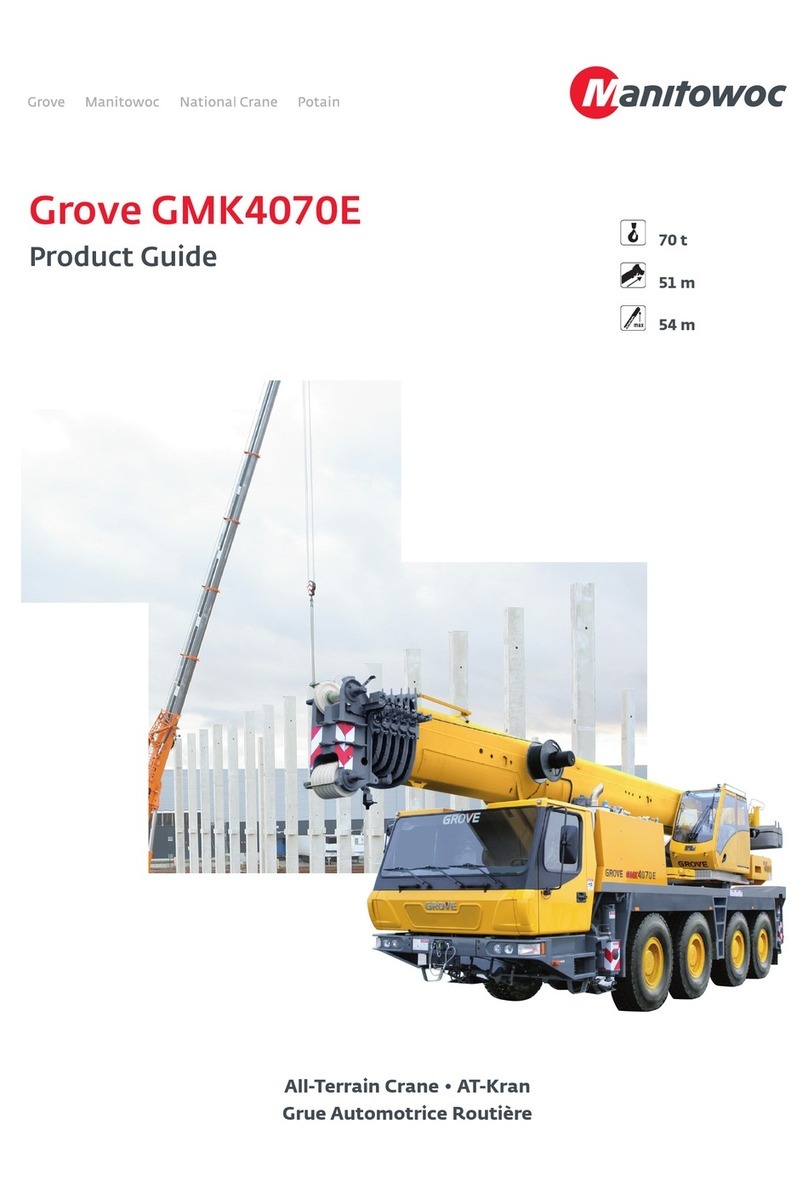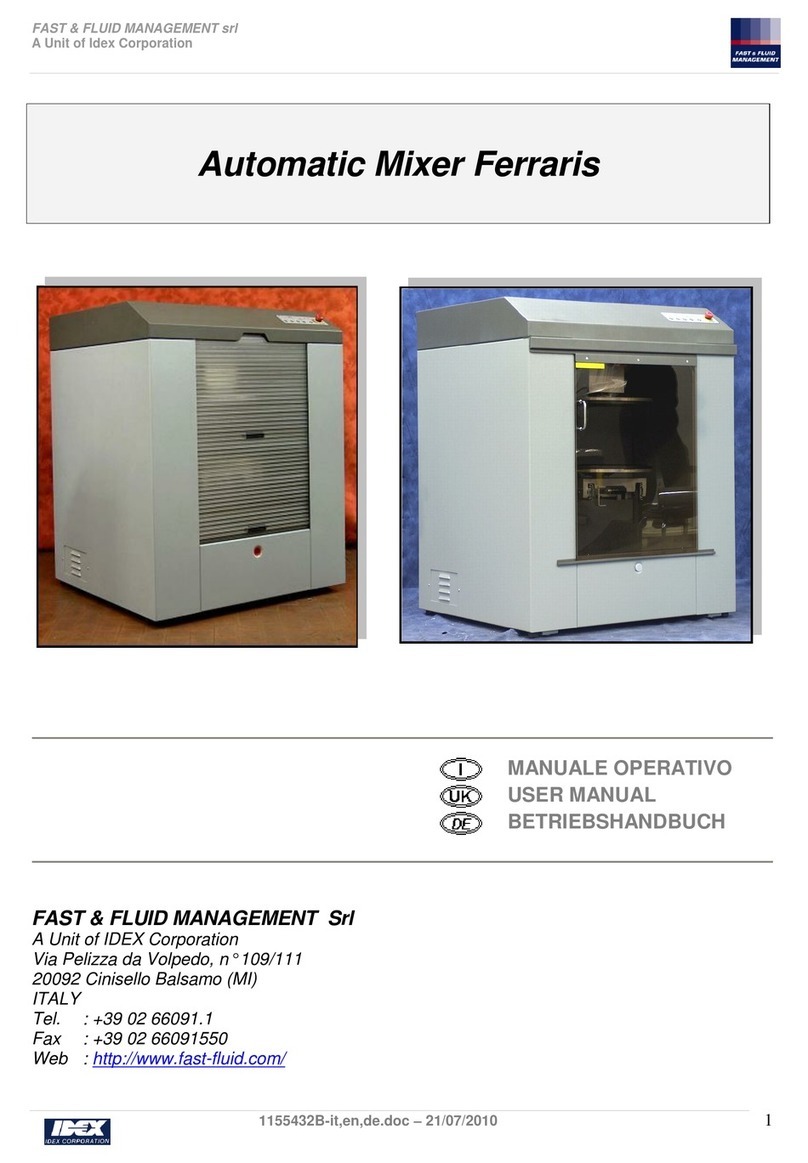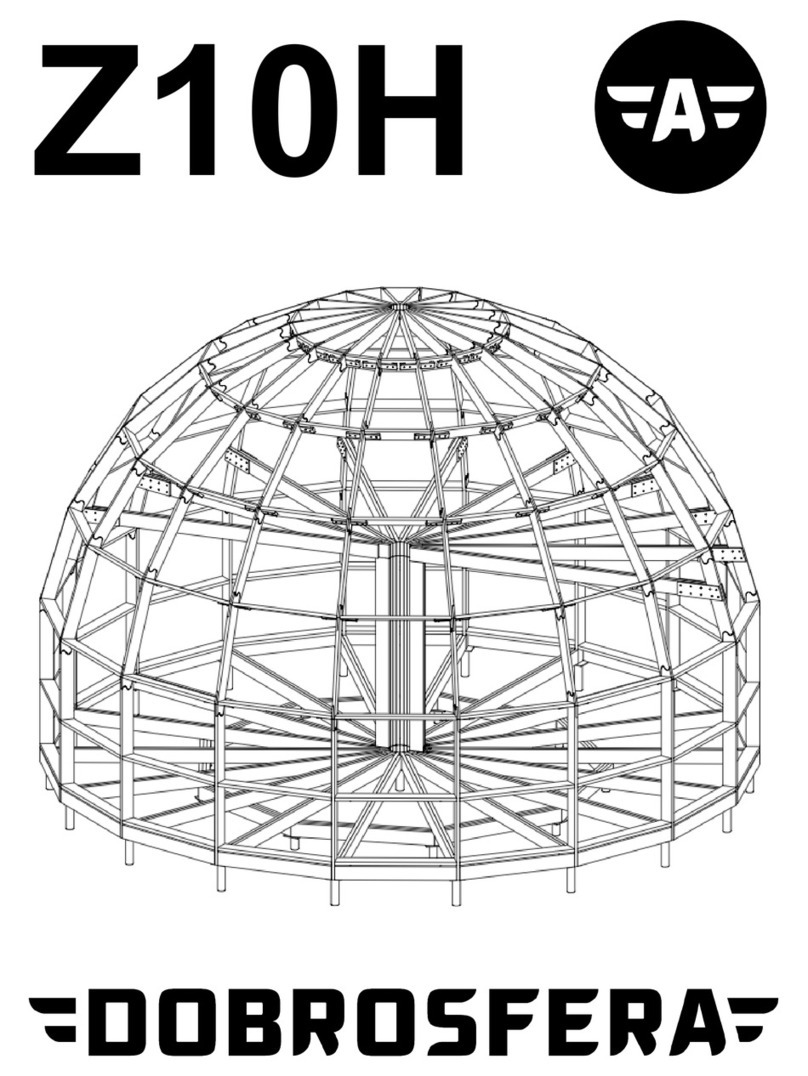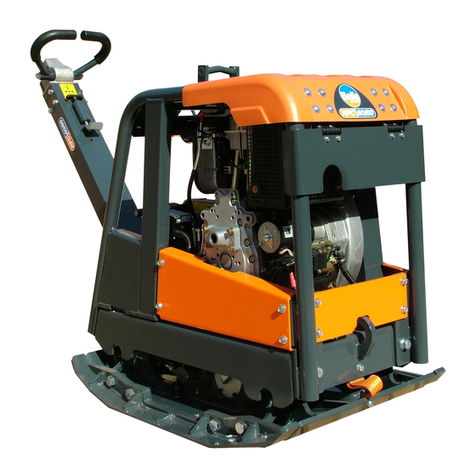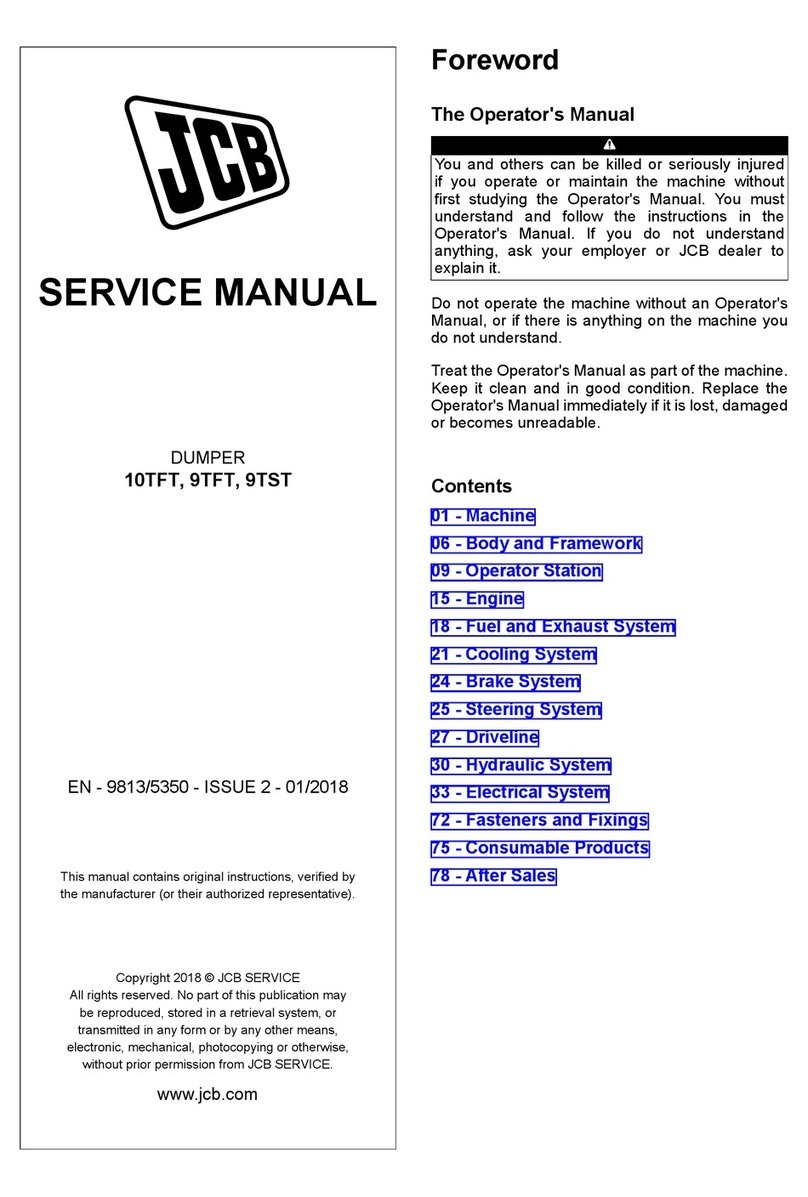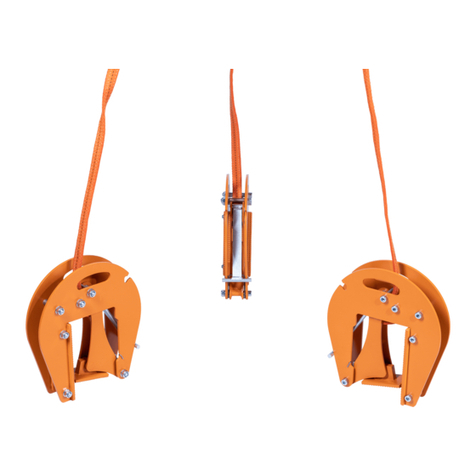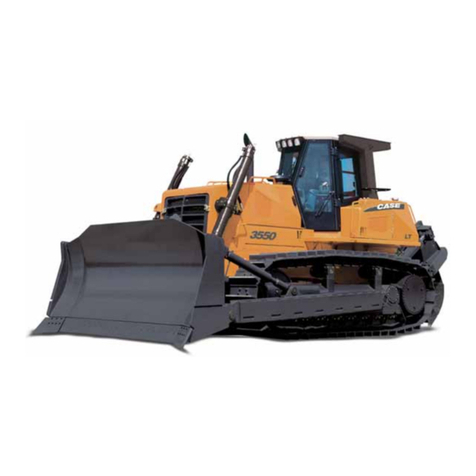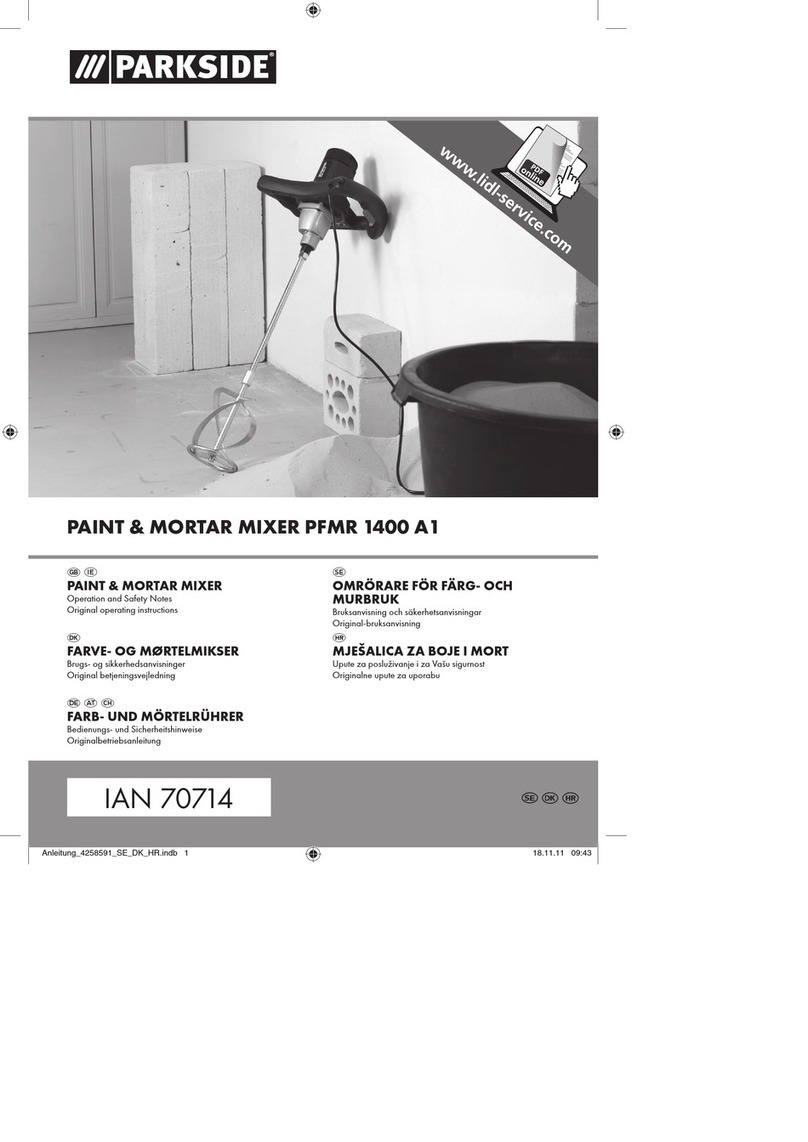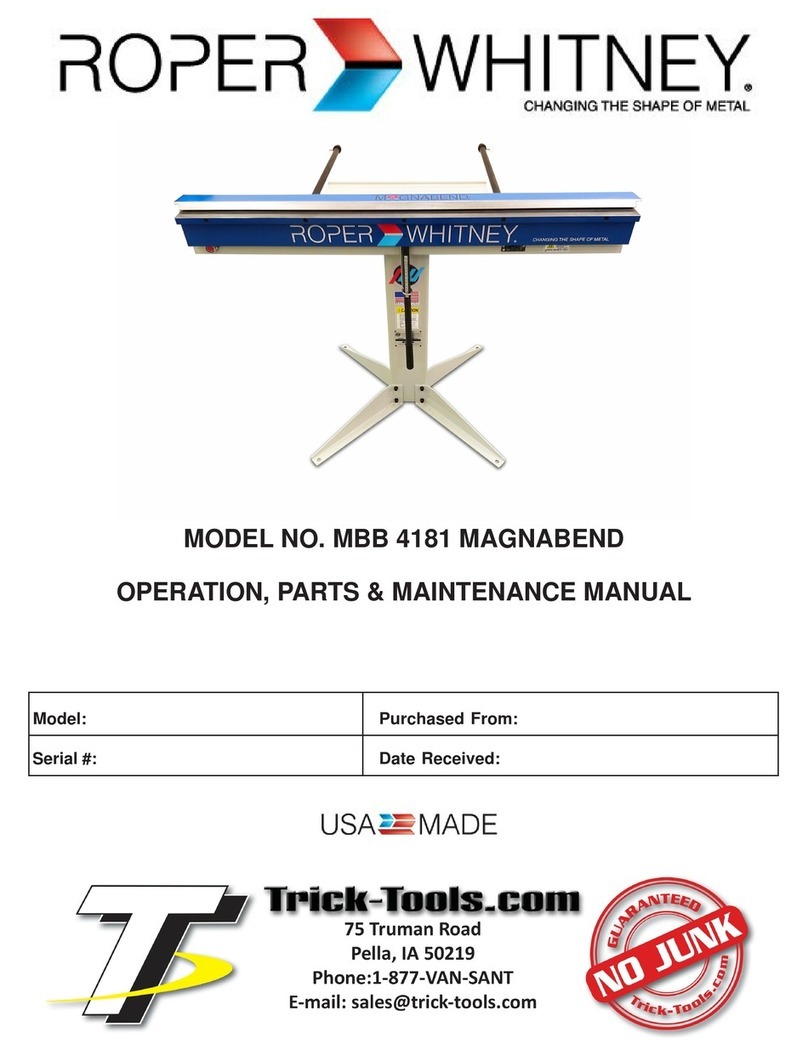Etnyre Black-Topper User guide

E.D. ETNYRE & CO. - 1333 S. Daysville Road - Oregon, Illinois 61061
Phone: 815-732-2116 or 800-995-2116 – Fax: 800-521-1107 – www.etnyre.com
Asphalt Distributor
with Touch Screen Controls
Operation - Maintenance - Safety
Black-Topper®
Starting with Serial Number S9000
Standard and Variable Width Spray Bar
With Touch Screen Controls
R
R
M-103-22

1
Starting with Serial Number S9000
Black-Topper Operation, Maintenance and Safety Manual
BLACK-TOPPER Distributor
Standard Spraybar or Variable Width Bar
with Touch Screen Controls
M-103-22

2
© Copyright 2021 E.D. Etnyre & Co.
All brand names, trademarks and registered
trademarks are the property of their respective
owners. Information contained within this
document is subject to change without notice.
All rights reserved.

3
Table of Contents
WARRANTY..............................................................1
Warning and Instruction Plates.................................5
GENERAL SAFETY INSTRUCTIONS
Safety Precautions, Hazard Seriousness Level .....7
Fluoroelastomer Handling ......................................8
Foaming................................................................10
Asphalt Institute ....................................................10
INTRODUCTION
Reporting Safety Defects...................................... 11
Component Location And Identication..........12–13
CAB TOUCH SCREEN CONTROL PANEL..........14
REAR TOUCH SCREEN CONTROL PANEL.......16
PREPARING FOR OPERATION
SETTINGS............................................................18
SETUP Page 1 .......................................................19
Calibrations.........................................................21
Left Bar, Right Bar Smart Cylinder
(Variable Width Bar Only) ..................................22
Pump EDC Threshold.........................................23
Ground Speed Radar Calibration ......................24
Tank Level Sensor Calibration............................25
Joysticks and Thumbwheels...............................25
SETUP Page 2 .......................................................26
Spray Marker Valves ..........................................26
Power Return Spray ...........................................26
SETUP Page 3 .......................................................27
USB / Computer Update:....................................27
Fault Control:......................................................27
Initialize LEDs:....................................................27
DISPLAY ................................................................28
Backlight:............................................................28
Touch Point:........................................................28
Screen Saver:.....................................................28
Voltage / Temp:...................................................28
Color Scheme:....................................................29
Volume:...............................................................29
FAULTS..................................................................30
Page 1 ................................................................30
Under Application .............................................30
Over Application ...............................................30
EDC Feedback Range......................................30
Zero Motor Speed (Motor Feedback) ...............30
Pump Calibration..............................................30
Radar Calibration..............................................30
Asphalt Temperature Sensor ............................30
Hydraulic Temperature Hot...............................31
Tank Level Sensor ............................................31
Tank Level - Bar Circ ........................................31
Tank Level - Burners.........................................31
Page 2 ................................................................31
Front Display ....................................................31
Rear Display.....................................................31
Front I/O Module...............................................31
Left Air Output Module......................................31
Right Air Output Module ...................................31
Hydraulic Output Module..................................32
Accessories Output Module..............................32
Other CAN Modules .........................................32
Computer IOs ...................................................32
Left Variable Width Spray Bar ..........................32
Right Variable Width Spray Bar ........................32
DIAGNOSTICS.....................................................33
Page 1 ................................................................33
Spray Valves.....................................................33
Page 2 ................................................................34
Page 3 ................................................................34
HELP ......................................................................35
View PDFs..........................................................35
INFORMATION ......................................................36
Pump Meter.........................................................36
LIGHTS ..................................................................37
Maximum Current Draw [Amps]..........................37
OPERATION
Main Controls .......................................................38
Operation Mode..................................................38
Pump Control......................................................38
Page 1 ................................................................39
Two Speed Motor (if equipped): .......................39
Smart Clean (if equipped):................................39
Burner Control ..................................................40
Ignition and Out Fire Control...............................41
Fuel Oil Burners..................................................41
Tank Valve (if equipped): ........................................42
Suck Back Bar Circ (if equipped):.....................42
Page 2 ................................................................42
Taper Switch (Optional) ....................................43
Marker Valves (if equipped...............................43
Wash Pump (if equipped): ................................43
Page 3 ................................................................44
Spray Totals......................................................44
Log Spray Totals ..............................................44
Tank Capacity ...................................................45
ASPHALT OPERATIONS
Loading Through the Manhole..............................46
Loading Through the Load Line............................47
Connections and Preliminary Checks.................47
Check Strainers..................................................47
Using the Measuring Stick..................................47
Circulating in the Tank .........................................50
Circulating in the Spray Bar..................................52
Spraying Through the Spray Bar .........................54
Spray Bar Suck Back............................................56
Nozzle Range Indicator ........................................59
Spraying With the Hand Spray ............................60
Handspray Suckback............................................62
SUCKBACK...........................................................62
Suck Back Override..............................................63
BAR FLUSHING OPERATIONS............................64
UNLOAD OPERATIONS........................................66
with External Pump...............................................66
with Distributor Pump ...........................................68
TRANSFER OPERATIONS ...................................70
HEATING PRODUCT IN DISTRIBUTORS
Heating with Propane Burners..............................72
Heating with Fuel Oil Burners...............................75
Troubleshooting....................................................77
MaintenanceMaintenance..........................................................78
ELECTRICAL SCHEMATIC..........................84-91
Lubrication Chart..................................................92
APPENDIX A - Valve Abbreviations - Standard Bar.......93
APPENDIX B - Valve Abbreviations - Variable WidthBar ..94
APPENDIX C - USB application Update......................95
APPENDIX D - Default GPM & LPM Chart ...................96
Etnyre Spraybar Nozzles .....................................97
Serial Number Plate Location..............................98

4
List of Illustrations
Figure 1 - Location of Warning and Instruction Plates.......5
Figure 2 - Flashing Low Level Indicator........................... 10
Figure 3 - Low Tank - Burners fault ................................. 10
Figure 4 - Rear and Side Component Identication ........ 12
Figure 5 - Rear Component Identication........................ 12
Figure 6 - Spray Bar Component Identication ............... 13
Figure 7 - Hydraulic Tank Component Identicaiton........ 13
Figure 8 - Cab Control Panel Components ..................... 14
Figure 9 - Rear Control Panel Components .................... 16
Figure 10 - Gear Icon ...................................................... 18
Figure 11 - Setup Button.................................................. 18
Figure 12 - Setup Login Button........................................ 18
Figure 13 - Page 1 of Setup Screen................................ 19
Figure 14 - Pump Threshold Description......................... 19
Figure 15 - Reset Defaults button.................................... 20
Figure 16 - Memory Window and Keyboard.................... 21
Figure 17 - Machine Calibrations button.......................... 21
Figure 18 - Machine Calibrations Window....................... 22
Figure 19 - Left Bar Smart Cylinder START Calibrate Window . 22
Figure 20 - Hydraulic Pump EDC Threshold Calibration. 23
Figure 21 - Pump Calibration Fault.................................. 23
Figure 22 - Ground Speed Radar Calibration.................. 24
Figure 23 - Radar Height and Angle................................ 24
Figure 24 - Tank Level Sensor Calibration ...................... 25
Figure 25 - Calibrate Empty and Calibrate Full Buttons...25
Figure 26 - Page 2 of Setup Screen................................ 26
Figure 27 - Metric units White Bar .................................. 26
Figure 28 - Page 3 of Setup Screen................................ 27
Figure 29 - Faults Disabled Icon...................................... 27
Figure 30 - Display Screen.............................................. 28
Figure 31 - Front Display / Rear Display ......................... 29
Figure 32 - USB Icons ..................................................... 29
Figure 33 - Speaker Volume............................................ 29
Figure 34 - Page 1 of Faults Screen................................ 30
Figure 35 - Page 2 of Faults Screen................................ 31
Figure 36 - Page 1 of Diagnostics Screen....................... 33
Figure 37 - Page 2 of Diagnostics Screen....................... 34
Figure 38 - Help Screen .................................................. 35
Figure 39 - Black-Topper Computator ............................. 35
Figure 40 - Information Screen........................................ 36
Figure 41 - Pump Meter................................................... 36
Figure 42 - Lights Icon Button ......................................... 37
Figure 43 - Lights Screen ................................................ 37
Figure 44 - Lights Name Keyboard...................................37
Figure 45 - Home Screen, Page 1................................... 38
Figure 46 - Operation Mode ............................................ 38
Figure 47 - Pump Control ................................................ 39
Figure 48 - Motor Speed.................................................. 39
Figure 49 - Burner Control............................................... 40
Figure 50 - Smart Clean Window .................................... 40
Figure 51 - Tank Valve..................................................... 42
Figure 52 - Front Load Valve ........................................... 42
Figure 53 - Suck Back Bar Circ ....................................... 42
Figure 54 - Operation page 2 screen............................... 42
Figure 55 - Taper Switch.................................................. 43
Figure 56 - Marker Valves.................................................43
Figure 57 - Wash Pump................................................... 43
Figure 58 - Operation page 3 screen............................... 44
Figure 59 - Log Spray Totals ........................................... 44
Figure 60 - Tank Level ..................................................... 45
Figure 61 - Valve Positions for Loading Through the Manhole... 46
Figure 62 - Using the Measuring Stick ............................ 47
Figure 63 - LOAD Operation Mode.................................. 48
Figure 64 - Increasing Pump Speed Slider...................... 48
Figure 65 - LED Tank Gauge Bar .................................... 48
Figure 66 - Valve Positions for Loading Through the Load Line..... 49
Figure 67 - TANK CIRC Operation Mode ........................ 50
Figure 68 - Valve Positions for Circulating in the Tank .... 51
Figure 69 - BAR CIRC Operation Mode .......................... 52
Figure 70 - Valve Positions for Circulating in the Spray Bar ......53
Figure 71 - Bar Latch Symbol.......................................... 54
Figure 72 - Valve Positions for Spraying Through the Spray Bar ... 55
Figure 73 - Suck Back Operation Mode .......................... 56
Figure 74 - Valve Positions for Spray Bar Suck Back...... 57
Figure 75 - Open Nozzles Flashing Green...................... 58
Figure 76 - Auto Spray Mode........................................... 58
Figure 77 - Manual Spray Mode...................................... 58
Figure 78 - Handspray Operation Mode.......................... 60
Figure 79 - Valve Positions for Spraying With the Hand Spray. 61
Figure 80 - Suck Back Override ...................................... 63
Figure 81 - Flush Operation Mode................................... 64
Figure 82. Valve Positions for Flushing ........................... 65
Figure 83 - Unload Operation AUTO Mode ..................... 66
Figure 84 - Valve Positions for Unload with External Pump 67
Figure 85 - Unload Operation MANUAL Mode ................ 68
Figure 86 - Valve Positions for Unload with Distributor Pump .. 69
Figure 87 - Transfer Operation Mode .............................. 70
Figure 88 - Valve Positions for Transfer .......................... 71
Figure 89 - Ignition & Out Fire Control System................ 73
Figure 90 - Gun Assembly............................................... 78
Figure 91 - Electrode Setting........................................... 78
Figure 92 - Right Hand / Left Hand Electrodes ............... 78
Figure 93 - Hydraulic Motor............................................. 79
Figure 94 - Etnyre Asphalt Pump..................................... 80
Figure 95 - Fluid Cleanliness Chart................................. 82

5
30
30
Warning and Instruction Plates
For operator safety and possible liability protection, all Safety and Instruction Plates should
remain in place and be legible
Should a plate be removed, lost, or become illegible, reorder and replace immediately
If plates become difcult to read because of material coating the surface, clean with solvent
30 6705038 1 Gauge-Tank, LED
Figure 1. Location of Warning and Instruction Plates

6
NOTICE
The handling of Cationic Emulsions (CRS-2, CMS-2, CSS-1 and CSS) may create an
environment within the Asphalt Distributor that can be corrosive to carbon steel and
cast iron.
• Cationic Emulsions are widely used within the industry.
• Cationic Emulsion is manufactured with asphalt, water, emulsiers and
hydrochloric acid. The chemistry of individual emulsions varies in asphalt content
and Ph levels.
• Tanks and spray mechanisms used with Cationic emulsions may experience
corrosion
• It is believed the chemistry of the emulsion - specically the residual fumes
promote the corrosion
• Etnyre Distributors are compatible with Cationic Emulsions provided that certain
precautions are taken.
• Prior to placing a distributor in to service with Cationic Emulsion, it should be
loaded with an AC or MC type material to develop a protective coating.
• Periodic inspection of the tank and spray system should be preformed in the
normal course of operation.
• It is recommended that distributors used in Cationic service be ushed periodically
and at the end of the season with an AC, MC or cutback to remove the corrosive
materials and to provide a protective coating.
• Increasing the quantity of ushing material during daily suck back and cleanout
operations will also help to minimize corrosion damage.
• Dilution is the solution.
• Additional information can be acquired from your Emulsion supplier as well as the
Asphalt Institute or the Asphalt Emulsion Manufactures Association.
WARNING
Take extra care and follow recommended
procedures when alternating asphalt
materials especially when loading hot
product, over 212 degrees Fahrenheit
emulsion was used in the previous load.
(100 degrees Celsius), on to a tank and
system previously in Emulsion service.

7
GENERAL SAFETY INSTRUCTIONS
The operation of a bituminous distributor normally requires handling of liquid products at elevated temperature.
Also, these liquids may be of a volatile nature. A heating system is supplied to raise or maintain the product
temperature, and these systems use highly combustible fuels. As with any type of construction equipment, there
are certain hazards associated with careless or improper operation.
Safety warnings have been provided to call attention to any potentially hazardous situation that may cause property
damage, personal injury or death to the operator or bystanders. These safety warnings will be shown at various
times throughout this manual, as they are applicable to the subject being presented. These safety warnings are
identied by the following warning symbols:
Safety Precautions, Hazard Seriousness Level
You will nd safety information boxes throughout this manual. These boxes contain information alerting you to
situations or actions to avoid.
Signal words (DANGER, WARNING, and CAUTION) are used to identify levels of hazard seriousness. Their
selection is based on the likely consequence of human interaction with a hazard. Denitions of hazard levels are
as follows.
DANGER - Immediate hazards which will result in severe personal injury or death.
WARNING - Hazards or unsafe practices which could result in severe personal injury or death.
CAUTION - Hazards or unsafe practices which could result in minor personal injury or product or
property damage.
All of these warnings are listed below and they also appear throughout the manual. In addition to these, you will
nd notes throughout the manual.
NOTE - A note provides general information that the operator should be aware of when performing an operation.
DANGER
To avoid an extreme re hazard or explosion,
NEVER use gasoline as fuel in diesel or fuel
oil burners.
DANGER
A fully charged dry chemical type re
extinguisher must be within easy reach
whenever the burners are operating or there
is an open ame near the Distributor. The
minimum capacity of the re extinguisher
should be 10 pounds.
Please Note This Warning
and Remember:
• Always start and operate the engine in a
well ventilated area.
• If in an enclosed area, vent the exhaust
to the outside.
• Do not modify or tamper with the exhaust
system.
WARNING
To prevent an explosion or re hazard:
• Position the unit broadside to the wind to
prevent volatile fumes from drifting toward
the burners.
• Do not operate the burners if the tank is
damaged or leaking.
• Ensure that the burners are extinguished
before removing any material from the tank
in any manner. Liquid petroleum (LP) burners
can support a ame for several minutes after
the fuel supply is turned off.

8
GENERAL SAFETY INSTRUCTIONS
WARNING
A fully charged dry chemical type re
extinguisher must be within easy reach
whenever the burners are operating or there is
an open ame near the Distributor. The minimum
capacity of the re extinguisher should be 10
pounds.
Fluoroelastomer Handling
Some O-rings and seals used in this vehicle
are made from uoroelastomers, When used
under design conditions, uoroelastomers do
not require special handling. However, when
uoroelastomers are heated to temperatures
beyond their design temperature (around 600º
Fahrenheit), decomposition may occur with the
formation of hydrouoric acid. Hydrouoric acid
can be extremely corrosive to human tissue if
not handled properly.
A degraded seal may appear as a charred or
black sticky mass, Do not touch either the seal
or the surrounding equipment without wearing
neoprene or PVC gloves if degradation is
suspected. Wash parts and equipment with
10% lime water (calcium hydroxide solution) to
neutralize any hydrouoric acid.
If contact with the skin occurs, wash the affected
areas immediately with water. Then rub a 2.5
calcium gluconate gel into the skin until there
is no further irritation, while seeking prompt
medical attention.
Note to Physicians: For advice or treatment of
HF burns, call the DuPont Medical Emergency
number, 1-800-441-3637.
WARNING
To prevent an explosion or re hazard:
• Do not operate the burners when the vehicle is
unattended, when the vehicle is in motion, or
with the vehicle in a conned area.
• When the burners go out, shut off the fuel
supply to both burners and allow the ues to
ventilate for at least 3 minutes before re-lighting
the burners.
• Do not heat the material beyond the
manufacturer’s recommended temperature.
• Keep burning cigarettes or other sources of
combustion away from manholes and overow
vents.
• Keep area free of all sources of combustion
when spraying.
• Check the tank vent to insure that it is free from
obstruction before lighting the burners.
• Eliminate sparks from engine exhaust.
• Do not operate the burners with the manhole
open or open the manhole while the burners
are in operation.
• Flues must be covered by a minimum 6 inches
of material (bitumen) when burners are in
operation.
To prevent possible hand or facial burns:
• Always light the inside burner rst. Do not
reach across a lit burner to light or re-light
the inside burner. Shut off the outside burner
before lighting the inside burner.
To prevent possible burns:
• Always use a torch to light the burners. Never
attempt to light the burners using a match or
pocket lighter.
• Always wear insulated gloves when handling
spray bar sections or hoses.
• Always wear eye protection, face shield, long
sleeve shirt, insulated gloves, boots, and long
pants outside the boots when working around
the Distributor.
• Use extreme caution when using a torch to
heat the pump. Asphalt accumulated around
the pump may ignite when heating the pump
with a torch.
WARNING
To prevent possible injury:
• Always open the manhole cover slowly.
Pressure build up in the tank may cause the
cover to burst open.
To prevent possible re hazards, burns or
falls:
• Keep the unit clean for safe operation.

9
GENERAL SAFETY INSTRUCTIONS
()
WARNING
WARNING
If a ue is not covered by 6” of material, the corre-
00
100
Using the Measuring Stick

10
GENERAL SAFETY INSTRUCTIONS
than 25% full. The product should then be circulated
through the spray bar at a rate of 10 to 20 GPM before
continuing the loading operation.
If foaming does occur, continue circulating until the
foaming stops, and then suck back the product in the
spray bar back into the tank before lling the tank the
rest of the way.
Asphalt Institute
To further increase awareness of the hazards
associated with the operation of a bituminous
distributor, and before beginning initial operation,
the operator should also receive instruction by an
authorized Etnyre dealer, or Etnyre representative.
The Centennial Distributor is designed to handle a
number of different products, such as ACs, cutbacks
& emulsions.
Knowledge of these liquid asphalts is required for safe
operation of the Distributor. It is critical to know which
product can be loaded after the previous product, and
which products react with each other.
The Asphalt Institute is a source of asphalt handling
safety information.
www.asphaltinstitute.org
email: [email protected]
sponding burner indicator (Lower or Upper) will
ash white to red at one second intervals to warn
the operator. The Low Tank - Burners fault will acti-
vate on the Faults page. If a ue has low coverage,
its ON button must be held for one second to start
the burner as a safety precaution.
If the warning is active and the burner ON button is
pressed, the fault Burners - Low Level will become
active on the faults page.
Figure 2. Flashing Low Level Indicator
Figure 3. Low Tank - Burners fault
Foaming
If the Distributor is to be lled with hot bitumen,
proceed very cautiously. If there is any moisture in
the tank, or if an emulsion product was the last load,
foaming or eruption may occur.
Dow-Corning DC-200 may be used to prevent foaming
in Distributors, Transports, and Maintenance Units.
Mix the contents of one can (16 oz.) with one (1) gallon
of diesel fuel or kerosene. Add one (1) oz. of this
diluted mixture to each 1000 gallons of asphalt. The
correct amount may be poured through the manhole.
This will assist in reducing foaming, particularly if
moisture is present or if an emulsied asphalt was
used in a previous load.
If foaming does not occur at the start of the loading
operation, but you suspect that there may be moisture
in the spray bar or circulating system, the loading
operation should be stopped when the tank is no more
WARNING
To prevent possible burns from foaming
or violent eruption:
• Do not load tank with material temperature
over 200° F if water or condensation is
present in tank, or if emulsion was used in
the previous load.
•Do not heat material over 200° F if moisture
or emulsied material is present in tank.
To prevent possible burns from material
overow:
• Allow sufcient space in the tank for
expansion of the material when heating
• Before removing the ll line cap, make
certain that the asphalt pump is turning and
the tank valve is closed.
WARNING

11
INTRODUCTION
Your touchscreen controlled Etnyre Black-Topper® Distributor is designed to give you many years of accurate,
dependable, and economic service. The following instructions enable you to receive the maximum performance
from your Blacktopper® Distributor.
The Black-Topper® Distributor’s controls are designed for simple operation. They require a minimum of training
for procient usage. The exclusive Etnyre circulating system is designed and built for efcient handling of all
grades of bituminous materials.
This manual is provided as a tool to aid personnel in the operation of the Etnyre Black-Topper® Distributor in a
safe and efcient manner. As with any type of construction equipment, there are certain hazards associated with
improper or careless operation. The ability to read and understand the instructions in this manual is a required
qualication to operate this machine. There are functions that required a certain amount of physical strength to
accomplish. Persons lacking the required strength will not only place themselves in jeopardy, but also others in
the vicinity.
This manual covers standard features and options for truck mounted units with touch screen computerized
controls. If your unit incorporates custom features, some of the information contained in this manual may not
apply. If you have any questions regarding this manual or your unit, contact your Etnyre dealer or the E.D. Etnyre
service department at 1 (800) 995-2116.
To turn on the Etnyre Blacktopper distributor, the power switch in the front control box must be turned on, and
the emergency stopped in the rear control box must be released. The touchscreen display always begins in its
Home page, in the Load operation mode, and manual pump control.
Reporting Safety Defects
If you believe that your vehicle has a defect which
could cause a crash, or could cause injury or death,
you should immediately inform the National Highway
Trafc Safety Administration (NHTSA) in addition to
notifying E. D. Etnyre & Co.
If NHTSA receives similar complaints, it may open an
investigation; and, if it nds that a safety defect exists
in a group of vehicles, it may order
a recall and remedy
campaign. However, NHTSA cannot become involved
in individual problems between you, your dealer, or
E. D. Etnyre & Co.
To contact NHTSA, you may either call the Auto Safety
Hotline toll free at 1-800-424-9393 (or 336-0123 in
the Washington, D.C. area) or write to NHTSA, U.S.
Department of Transportation, Washington, DC,
20696. You can also obtain other information about
motor vehicle safety from the hotline.
CAUTION
Unusually strong electromagnetic
interference could cause the electronic
controls on this equipment to temporarily
malfunction. Test the effect of two way
radios and similar equipment while
operating in a safe area.

12
INTRODUCTION
4 Way Valve Control
Rotary Actuator
Suction
Screen
Optional Front Suction Valve
Rear
Suction
Valve
Asphalt Pump
Drive Motor
Asphalt Pump Gearbox
Right Spray Bar
Carry Tube
Asphalt Pump
Right Spray Bar
Feed Tube
Left Spray Bar
Feed Tube
Hand Spray Gun
Left Spray Bar Carry Tube
Suck Back Valve Control
Strainer/Valve Box
Handspray Valves
Transfer Valve
Return Valve
Transfer Line
Transfer Line
Suck Back Valve
Fill Line
Fill Line Strainer
(Optional)
Hand Spray Gun Valve
Right Wing Section
with Spray Valves
Left Wing
Section
8' Center Section
with Valves and
Nozzles
Spray Valve
Flip Lever
Breakaway
Swivel Joint
Nozzle
Hydraulic Oil Tank
Hydraulic Oil Filters
(Location depends per unit)
LPG Tank
(may be on right or left side)
Fuel Oil Burner Fuel Tank
on right side frame when
applicable
Thermometer Well
Tool Box and
Rear Control Panel
Hose Trough
Transfer Line
Fill Line
Fill Line Strainer
Manhole & Platform
LED Tank Gauge
Exhaust Stack Dampers
Exhaust Stacks
Hand
Spray
Gun
Ladder
Burners
Sample Valve
Air Oiler
(in right side
tool box)
Suction Valve
Strainer/Valve Box
Asphalt Pump
Spray Bar
Lift Cylinder
Bar
Latch
with one foot controls
Spray Bar Feed Tube
8' Spray bar
Figure 2. Rear and Side Component Identification
(Location depends per unit)
Figure 4. Rear and Side Component Identication
Figure 5. Rear Component Identication

13
INTRODUCTION
Right Wing Section
with Spray Valves
Left Wing
Section
8' Center Section
with Valves and
Nozzles
Spray Bar
Feed Tubes
Spray Valve
Flip Lever
Breakaway
Swivel Joint
Nozzle
Nozzle
Spray Valve
Spray Valve Control Linkage
and Air Cylinder
Standard Spray Bar Components
Hydraulic T
ank Components
1
2
1
3
8
8
3
4
5
6
7
1. Hydraulic Filter
2. Thermo Switch
3. Mounting Bracket
4. Thermometer
5. Vented Breather Cap
6. Oil Eye Sight Plug
7. Hydraulic Tank Assembly
8. Vacuum Gauge Indicators
Figure 6. Spray Bar Component Identication
Figure 7. Hydraulic Tank Component Identication

14
INTRODUCTION
12a
11
12b
12c 12e
12d 12g12i 12k
12f 12h
12j 12l
12m
12n
CAB TOUCH SCREEN CONTROL PANEL
1. One Foot Switches (Bar Module)
The foot-switch LED module indicates status of
each set of three nozzles on the spray bar. Each
LED can be one of four different colors:
1.) GREEN: The foot switch is up, and the noz-
zles are on. Once in Spray mode, these noz-
zles will open, and the LED will be ashing
green at one second intervals.
2.) YELLOW: The foot switch is up, but the noz-
zles are off and will not spray. This could be
if the nozzle is tapered off, or if it is on a wing
that is folded up.
3.) RED: The foot switch is down. The nozzles
are off and will not spray.
4.) BLUE: Position of the taper switch. The noz-
zles are off, and all nozzles outside taper
switch position are off, and colored YELLOW
and/or RED.
2. MASTER SPRAY Switch
Turning this switch to ON opens all activated spray
valves when BAR CIRCULATE or SUCK BACK is
selected.
The spray valves are allowed to open in SUCK
BACK for troubleshooting.
3. WING FOLD Switches (Wing Module)
Spray bars have xed center sections and fold-
ing wings on both sides. Spray bars that have the
corresponding One Foot switches turned ON will
increase the spray width when the wing is lowered
and decrease the spray width when raised beyond
the wing tilt switch setting.
It is always a good practice to turn OFF the corre-
sponding One Foot switches before raising the wing
while spraying.
Figure 8 - Cab Control Panel Components

15
INTRODUCTION
4. POWER Switch
Both the POWER switch in the cab and the EMER-
GENCY STOP switch in the rear panel must be ON
for the control system to be ON.
The entire system can be shut down by turning
either switch to OFF. Before turning either switch ON
be sure you know what will automatically activate.
5.) Joystick
The Joystick shifts the spray bar left and right, and
moves it up and down. If the spray bar is latched, the
spray bar cannot shift left or right.
6. USB Charging Port
The USB port is a 5-volt charger for USB devices.
FOR CHARGING PURPOSES ONLY!!
7. Left Bar (Variable Width Bar only)
For variable bar units, the left bar thumbwheel will
shift the left spray bar left or right at four-inch incre-
ments.
8. Right Bar (Variable Width Bar only)
For variable bar units, the right bar thumb wheel
will shift the right spray bar left or right at four-inch
increments.
9. Left Taper
If the Taper Switch paid option is activated, the left
thumbwheel will move the left taper position in either
direction.
10. Right Taper
If the Taper Switch paid option is activated, the right
thumbwheel will move the right taper position in ei-
ther direction.
11 USB Data Port
FOR DATA PURPOSES ONLY! (See page 44)
12. TOUCH SCREEN DISPLAY
a.) Gear Icon
b.) Lights Icon
c.) English / Metric units
d.) Approximate volume of Material in Tank
(Gallons or Liters)
e.) Home Button
f.) Faults Disabled Icon
g.) Bar Latch Icon
h.) Handrails Up Icon
i.) USB Icon
j.) Burner Control Icon
k.) Spray Icon
l.) AUTO / MANUAL Pump Control Icon
m.) Asphalt Pump Speed (GPM or LPM)
n.) Cab Speaker Volume

16
INTRODUCTION
6a
6b
6c 6d 6f 6h 6j
6e 6g 6i
6k
6l
6m
REAR TOUCH SCREEN CONTROL PANEL
1. WING FOLD Switches
Spray bars have xed center sections and fold-
ing wings on both sides. Spray bars that have the
corresponding One Foot switches turned ON will
increase the spray width when the wing is lowered
and decrease the spray width when raised beyond
the wing tilt switch setting.
It is always a good practice to turn OFF the corre-
sponding One Foot switches before raising the wing
while spraying.
2. EMERGENCY STOP Switch
Both the POWER switch in the cab and the EMER-
GENCY STOP switch at the rear must be ON for the
control system to be on. The entire system can be
shut down by turning either switch to OFF.
Before turning either switch ON be sure you know
what will automatically activate. The EMERGENCY
STOP switch is turned Off by pushing in,
and turned On by rotating counter clockwise.
3.) Joystick
The Joystick shifts the spray bar left and right, and
moves it up and down. If the spray bar is latched, the
spray bar cannot shift left or right.
4. Left Bar (Variable Width Bar only)
For variable bar units, the left bar thumbwheel will
shift the left spray bar left or right at four-inch incre-
ments.
5. Right Bar (Variable Width Bar only)
For variable bar units, the right bar thumb wheel
will shift the right spray bar left or right at four-inch
increments.
6. TOUCH SCREEN DISPLAY
a.) Gear Icon
b.) Lights Icon
c.) English / Metric units
d.) Approximate volume of Material in Tank
(Gallons or Liters)
e.) Home Button
f.) Faults Disabled Icon
g.) Bar Latch Icon
h.) Handrails Up Icon
i.) USB Icon for Data Logging
j.) Burner Control Icon
k.) Spray Icon
l.) AUTO / MANUAL Pump Control Icon
m.) Asphalt Pump Speed (GPM or LPM)
Figure 9 - Rear Control Panel Components

17
PREPARING FOR OPERATION

18
PREPARING FOR OPERATION
SETTINGS
Before operating your Distributor, navigate to the Settings page by tapping the gear icon in the Header.
Eight (8) selections are available in Settings and will be explained throughout this manual. Factory is only
accessible by an Etnyre service technician and will be ignored.
1. Setup (Pages 19–27)
2. Display (Pages 28–29)
3. Network
4. Factory
5. Faults (Pages 30–32)
6. Diagnostics (Pages 33–34)
7. Help (Page 35)
8. Information (Page 36)
To get in machine Setup, touch the Setup button, enter the Setup password, and touch Login.
• Setup Password: 61061 (Oregon, Illinois ZIP code)
Figure 10 - Gear Icon
Figure 11 - Setup Button
Figure 12 - Setup Login Button
Be careful when entering the Setup pass-
word! Three consecutive login attempts
with an incorrect password will lock the
user out of setup for 5 minutes. Turning
the display off will only reset this timer.
NOTICE
Setup

19
PREPARING FOR OPERATION
SETUPSETUP
Page 1
Twelve (12) parameters are adjustable in Page 1 of the Setup screen. Tapping the parameter name it its header
will show a pop-up window describing that parameter. Exit by tapping anywhere on the pop-up window or the “X”.
• Pump Threshold
o Minimum required current for the asphalt pump to turn. Setting this too high may
prevent the pump from stopping. Setting this too low will prevent the pump from
being properly controlled at low speeds.
o Default: 400 milliamps (Rexroth), 15 milliamps (Danfoss)
• Minimum Flow
o Minimum pump ow rate in Bar Circulate and Spray modes. When all one-foot
switches are off, this is not used, and the ow rate goes to zero.
o Default: 5 gallons per minute
• Spray Delay ON
o Amount of time after turning the Master Spray Switch ON that the spray valves will
open. This allows time for the four way valve to turn before opening the spray bar.
o Default: 0.00 seconds
• Spray Delay OFF
o Amount of time after turning the Master Spray Switch OFF that the spray valves
will close. This allows time for the four way valve to turn before closing the spray bar.
o Default: 0.20 seconds
Figure 13 - Page 1 of Setup Screen
Figure 14 - Pump Threshold Description
Setup
Other manuals for Black-Topper
6
Table of contents
Other Etnyre Construction Equipment manuals
Popular Construction Equipment manuals by other brands
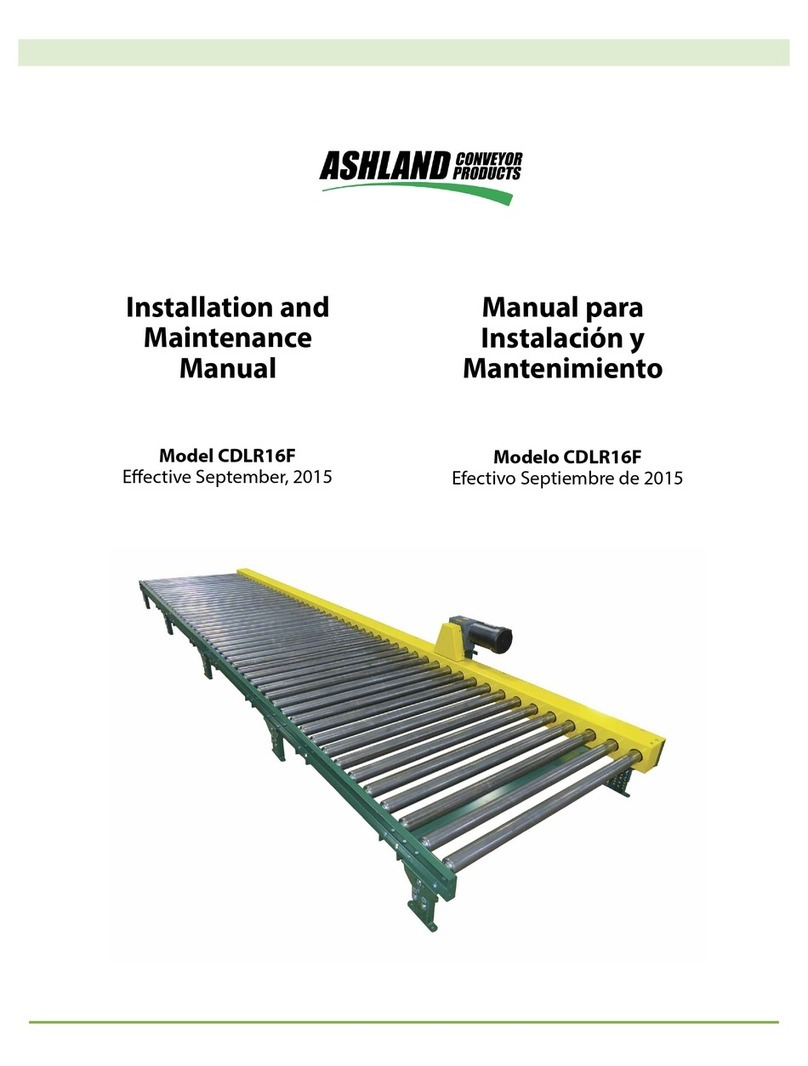
Ashland
Ashland CDLR16F Installation and maintenance manual
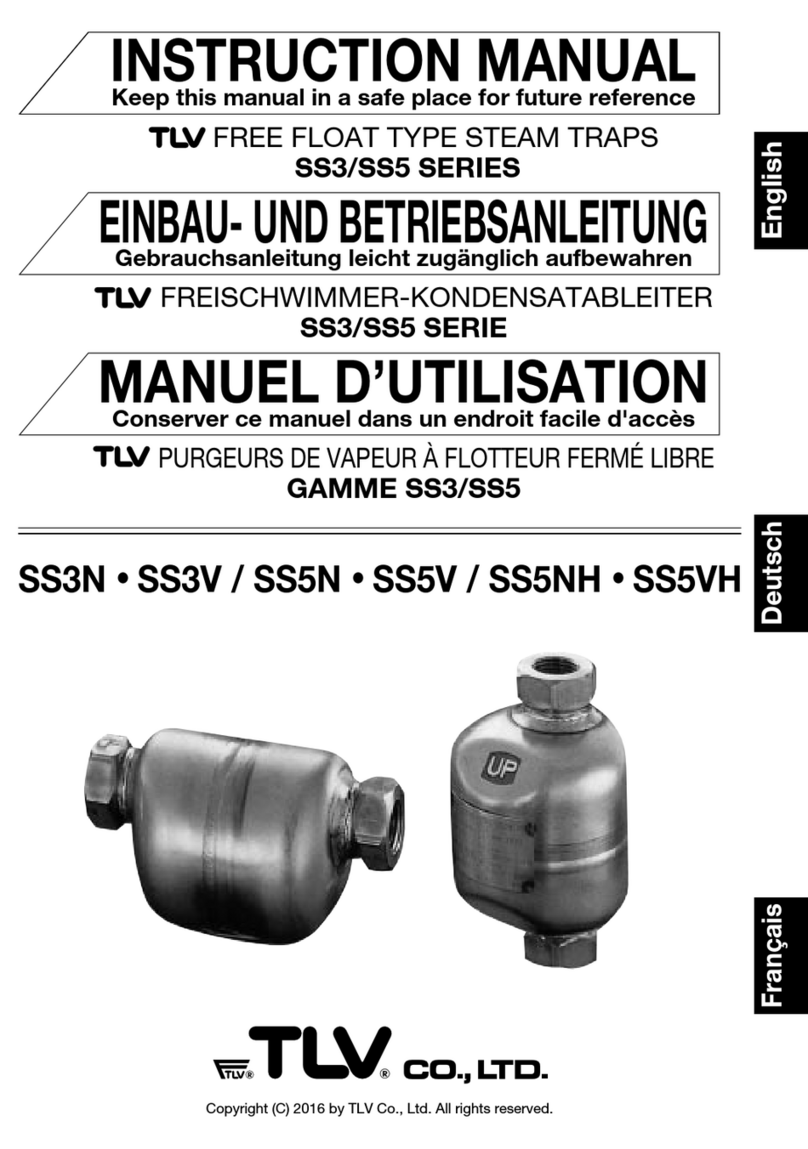
TLV
TLV SS3 Series instruction manual
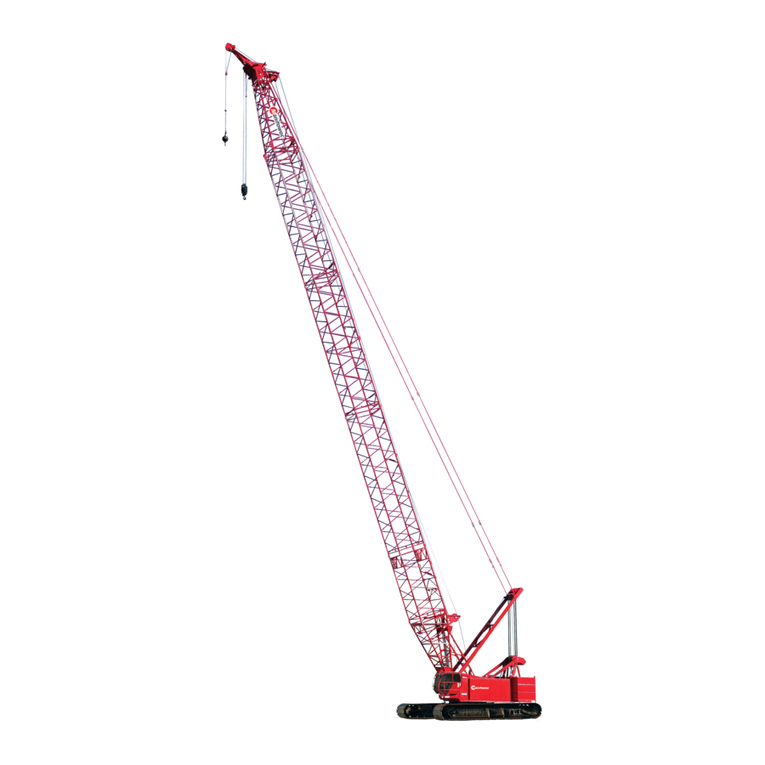
Manitowoc
Manitowoc 14000 Service and maintenance manual
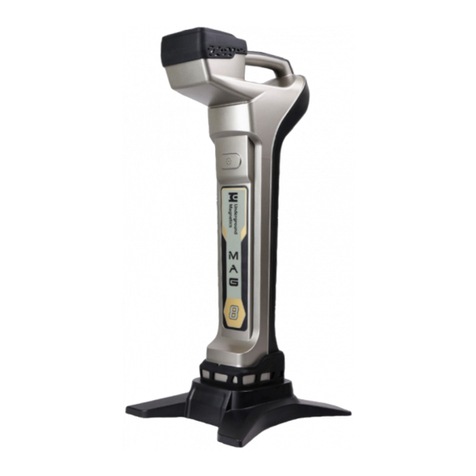
Underground Magnetics
Underground Magnetics Mag 8S manual
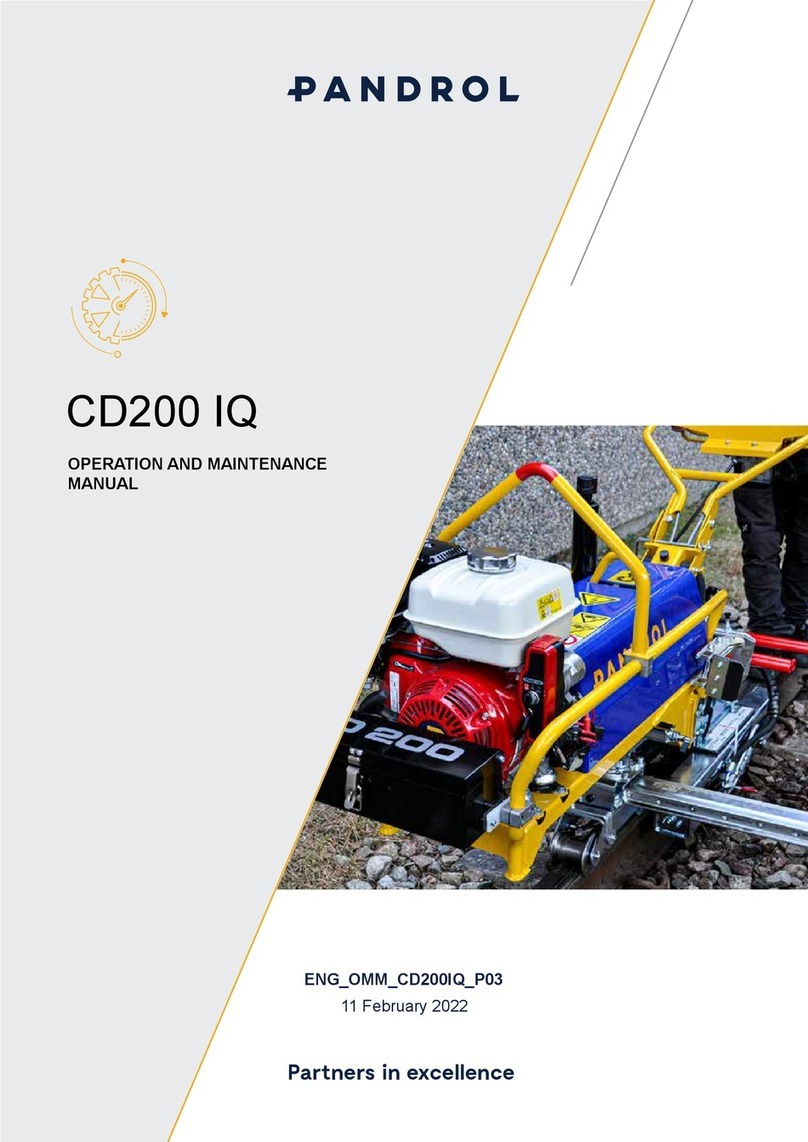
PANDROL
PANDROL CD200 IQ Operation and maintenance manual
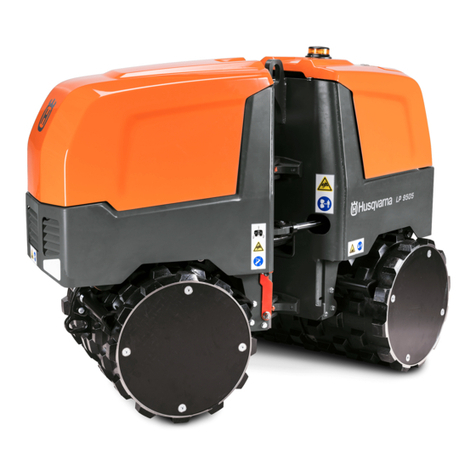
Husqvarna
Husqvarna LP 9505 Operator's manual
